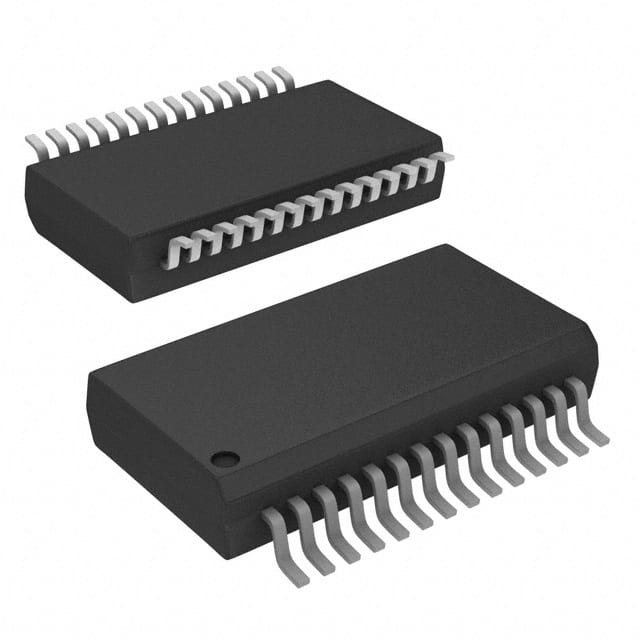Lihat spesifikasi untuk detail produk.

PIC16C63AT-20/SS
Product Overview
Category
The PIC16C63AT-20/SS belongs to the category of microcontrollers.
Use
This microcontroller is commonly used in various electronic devices and embedded systems for controlling and processing data.
Characteristics
- High-performance 8-bit RISC architecture
- Flash-based program memory
- Low power consumption
- Wide operating voltage range
- Integrated peripherals for enhanced functionality
Package
The PIC16C63AT-20/SS is available in a SSOP (Shrink Small Outline Package) package, which provides compactness and ease of integration into circuit boards.
Essence
The essence of the PIC16C63AT-20/SS lies in its ability to efficiently execute instructions and perform tasks in electronic systems, making it an essential component for many applications.
Packaging/Quantity
This microcontroller is typically packaged in reels or tubes, with each reel containing a specific quantity of units. The exact packaging and quantity may vary depending on the supplier.
Specifications
- Architecture: 8-bit RISC
- Program Memory Size: 7KB
- CPU Speed: 20 MHz
- Data Bus Width: 8-bit
- Operating Voltage Range: 2.5V to 5.5V
- Number of I/O Pins: 22
- Timers/Counters: 3
- Analog-to-Digital Converter (ADC): 8 channels, 10-bit resolution
- Serial Communication: USART, SPI, I2C
Detailed Pin Configuration
The PIC16C63AT-20/SS has a total of 28 pins. Here is the detailed pin configuration:
- VDD - Power supply voltage
- RA0 - General-purpose I/O pin
- RA1 - General-purpose I/O pin
- RA2 - General-purpose I/O pin
- RA3 - General-purpose I/O pin
- RA4 - General-purpose I/O pin
- RA5 - General-purpose I/O pin
- MCLR/VPP - Master Clear input/Voltage Programming input
- OSC1/CLKIN - Oscillator input
- OSC2/CLKOUT - Oscillator output
- RC0 - General-purpose I/O pin
- RC1 - General-purpose I/O pin
- RC2 - General-purpose I/O pin
- RC3 - General-purpose I/O pin
- RC4 - General-purpose I/O pin
- RC5 - General-purpose I/O pin
- VSS - Ground
- RB0/INT - General-purpose I/O pin/External Interrupt input
- RB1 - General-purpose I/O pin
- RB2 - General-purpose I/O pin
- RB3 - General-purpose I/O pin
- RB4 - General-purpose I/O pin
- RB5 - General-purpose I/O pin
- RB6 - General-purpose I/O pin
- RB7 - General-purpose I/O pin
- RB8 - General-purpose I/O pin
- RB9 - General-purpose I/O pin
- VDD - Power supply voltage
Functional Features
The PIC16C63AT-20/SS offers several functional features that enhance its capabilities:
- Flash-based Program Memory: Allows for easy reprogramming of the microcontroller, enabling flexibility in application development.
- Integrated Peripherals: Includes timers/counters, an analog-to-digital converter (ADC), and serial communication interfaces (USART, SPI, I2C), providing additional functionality for various applications.
- Low Power Consumption: Optimized power management ensures efficient operation and longer battery life in portable devices.
- Wide Operating Voltage Range: Can operate within a wide voltage range, making it suitable for diverse electronic systems.
Advantages and Disadvantages
Advantages
- High-performance RISC architecture enables fast execution of instructions.
- Flash-based program memory allows for easy reprogramming and flexibility in application development.
- Integrated peripherals provide enhanced functionality and reduce the need for external components.
- Low power consumption ensures efficient operation and longer battery life.
- Wide operating voltage range allows for compatibility with various power sources.
Disadvantages
- Limited program memory size may restrict the complexity of applications.
- Limited number of I/O pins may limit the connectivity options for certain projects.
- Lack of advanced features found in more modern microcontrollers.
Working Principles
The PIC16C63AT-20/SS operates based on an 8-bit Reduced Instruction Set Computer (RISC) architecture. It executes instructions stored in its flash-based program memory, which can be easily modified to suit different application requirements. The microcontroller interacts with external devices through its I/O pins and utilizes integrated peripherals such as timers/counters, ADC, and serial communication interfaces to perform various tasks.
Sebutkan 10 pertanyaan dan jawaban umum terkait penerapan PIC16C63AT-20/SS dalam solusi teknis
What is the operating voltage range of PIC16C63AT-20/SS?
- The operating voltage range of PIC16C63AT-20/SS is 2.0V to 5.5V.What is the maximum frequency of the internal oscillator in PIC16C63AT-20/SS?
- The maximum frequency of the internal oscillator in PIC16C63AT-20/SS is 20 MHz.Can PIC16C63AT-20/SS be used for motor control applications?
- Yes, PIC16C63AT-20/SS can be used for motor control applications with appropriate interfacing and programming.Does PIC16C63AT-20/SS have built-in analog-to-digital conversion (ADC) capability?
- No, PIC16C63AT-20/SS does not have built-in ADC capability.What are the communication interfaces supported by PIC16C63AT-20/SS?
- PIC16C63AT-20/SS supports serial communication interfaces such as UART and SPI.Is PIC16C63AT-20/SS suitable for battery-powered applications?
- Yes, PIC16C63AT-20/SS is suitable for battery-powered applications due to its low power consumption.Can PIC16C63AT-20/SS be programmed using a high-level language like C?
- Yes, PIC16C63AT-20/SS can be programmed using high-level languages like C with the appropriate compiler.What are the available I/O pins on PIC16C63AT-20/SS?
- PIC16C63AT-20/SS has a total of 22 I/O pins available for interfacing with external components.Does PIC16C63AT-20/SS have hardware support for pulse-width modulation (PWM)?
- Yes, PIC16C63AT-20/SS has hardware support for PWM, making it suitable for motor control and LED dimming applications.What development tools are available for programming and debugging PIC16C63AT-20/SS?
- Development tools such as MPLAB IDE and PICkit programmers/debuggers can be used for programming and debugging PIC16C63AT-20/SS.

